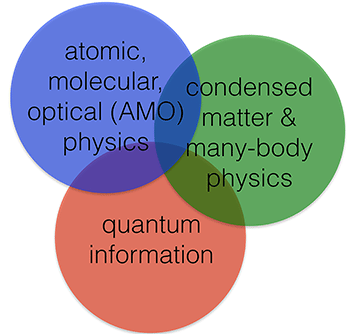Summary
The main long-term goals of our theoretical research group are to understand and control large interacting quantum systems, as well as to design and create new ones. To achieve these goals, we integrate tools and methods from quantum optics, atomic and molecular physics, condensed matter physics, and quantum information science.
Some specific goals of our research program are to
- Develop powerful new quantum technologies, including quantum computers, quantum internet, precise clocks, and accurate sensors.
- Use AMO (atomic, molecular, and optical) systems to address major questions in condensed matter and high energy physics via quantum simulation.
- Use AMO systems to study exotic many-body phenomena that are difficult to or impossible to access with other systems, with particular emphasis on far-out-of-equilibrium phenomena, time evolution, and dissipation.
Description

Differences between typical AMO and condensed matter systems bring with them exciting new physics. In contrast to condensed matter systems, AMO systems are often studied far out of equilibrium, are evolving in time, and are subject to dissipation. As a result, many-body AMO systems open a whole new world to understand, classify, and harness. One specific goal in this research direction is to extend methods available in condensed matter physics to these new types of systems.
Entanglement is a new tool that quantum information has recently given to the condensed matter community to study and even define phases of matter. At the same time, AMO experimentalists are very good at measuring and characterizing entanglement in AMO systems. Therefore, AMO systems will likely play a key role in studying entanglement in many-body systems. Thus we try to guide our research in the direction of understanding and measuring entanglement in many-body AMO systems.
Our theoretical research is always guided by and done in close collaboration with experimental groups. In fact, the true excitement often comes from experiments. Experiments also often bring new unexpected challenges whose solution often lies at the heart of our research.
More information about the Gorshkov Group:

